Yining Hua
Riemannian Geometry for the classification of brain states with intracortical brain-computer interfaces
Apr 07, 2025Abstract:This study investigates the application of Riemannian geometry-based methods for brain decoding using invasive electrophysiological recordings. Although previously employed in non-invasive, the utility of Riemannian geometry for invasive datasets, which are typically smaller and scarcer, remains less explored. Here, we propose a Minimum Distance to Mean (MDM) classifier using a Riemannian geometry approach based on covariance matrices extracted from intracortical Local Field Potential (LFP) recordings across various regions during different brain state dynamics. For benchmarking, we evaluated the performance of our approach against Convolutional Neural Networks (CNNs) and Euclidean MDM classifiers. Our results indicate that the Riemannian geometry-based classification not only achieves a superior mean F1 macro-averaged score across different channel configurations but also requires up to two orders of magnitude less computational training time. Additionally, the geometric framework reveals distinct spatial contributions of brain regions across varying brain states, suggesting a state-dependent organization that traditional time series-based methods often fail to capture. Our findings align with previous studies supporting the efficacy of geometry-based methods and extending their application to invasive brain recordings, highlighting their potential for broader clinical use, such as brain computer interface applications.
Detecting Conversational Mental Manipulation with Intent-Aware Prompting
Dec 11, 2024



Abstract:Mental manipulation severely undermines mental wellness by covertly and negatively distorting decision-making. While there is an increasing interest in mental health care within the natural language processing community, progress in tackling manipulation remains limited due to the complexity of detecting subtle, covert tactics in conversations. In this paper, we propose Intent-Aware Prompting (IAP), a novel approach for detecting mental manipulations using large language models (LLMs), providing a deeper understanding of manipulative tactics by capturing the underlying intents of participants. Experimental results on the MentalManip dataset demonstrate superior effectiveness of IAP against other advanced prompting strategies. Notably, our approach substantially reduces false negatives, helping detect more instances of mental manipulation with minimal misjudgment of positive cases. The code of this paper is available at https://github.com/Anton-Jiayuan-MA/Manip-IAP.
Applying and Evaluating Large Language Models in Mental Health Care: A Scoping Review of Human-Assessed Generative Tasks
Aug 21, 2024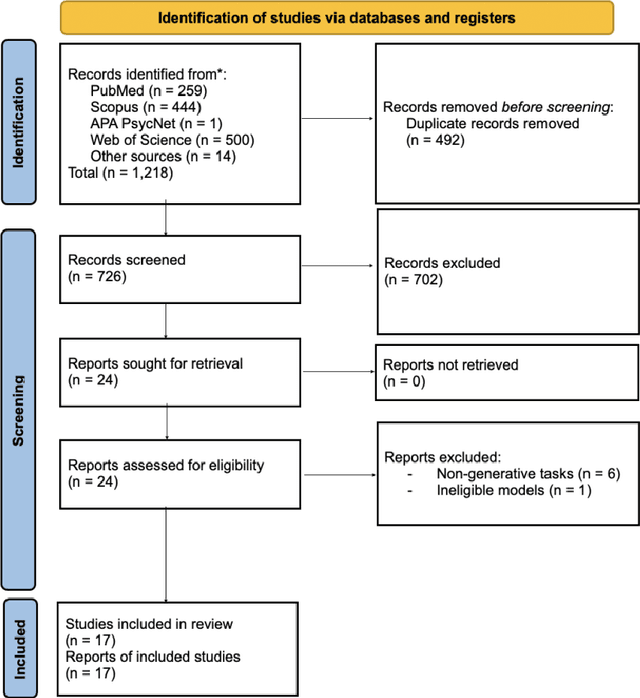


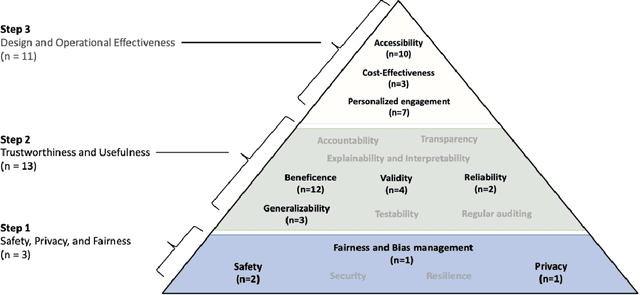
Abstract:Large language models (LLMs) are emerging as promising tools for mental health care, offering scalable support through their ability to generate human-like responses. However, the effectiveness of these models in clinical settings remains unclear. This scoping review aimed to assess the current generative applications of LLMs in mental health care, focusing on studies where these models were tested with human participants in real-world scenarios. A systematic search across APA PsycNet, Scopus, PubMed, and Web of Science identified 726 unique articles, of which 17 met the inclusion criteria. These studies encompassed applications such as clinical assistance, counseling, therapy, and emotional support. However, the evaluation methods were often non-standardized, with most studies relying on ad hoc scales that limit comparability and robustness. Privacy, safety, and fairness were also frequently underexplored. Moreover, reliance on proprietary models, such as OpenAI's GPT series, raises concerns about transparency and reproducibility. While LLMs show potential in expanding mental health care access, especially in underserved areas, the current evidence does not fully support their use as standalone interventions. More rigorous, standardized evaluations and ethical oversight are needed to ensure these tools can be safely and effectively integrated into clinical practice.
Vision-Language Models Meet Meteorology: Developing Models for Extreme Weather Events Detection with Heatmaps
Jun 14, 2024



Abstract:Real-time detection and prediction of extreme weather protect human lives and infrastructure. Traditional methods rely on numerical threshold setting and manual interpretation of weather heatmaps with Geographic Information Systems (GIS), which can be slow and error-prone. Our research redefines Extreme Weather Events Detection (EWED) by framing it as a Visual Question Answering (VQA) problem, thereby introducing a more precise and automated solution. Leveraging Vision-Language Models (VLM) to simultaneously process visual and textual data, we offer an effective aid to enhance the analysis process of weather heatmaps. Our initial assessment of general-purpose VLMs (e.g., GPT-4-Vision) on EWED revealed poor performance, characterized by low accuracy and frequent hallucinations due to inadequate color differentiation and insufficient meteorological knowledge. To address these challenges, we introduce ClimateIQA, the first meteorological VQA dataset, which includes 8,760 wind gust heatmaps and 254,040 question-answer pairs covering four question types, both generated from the latest climate reanalysis data. We also propose Sparse Position and Outline Tracking (SPOT), an innovative technique that leverages OpenCV and K-Means clustering to capture and depict color contours in heatmaps, providing ClimateIQA with more accurate color spatial location information. Finally, we present Climate-Zoo, the first meteorological VLM collection, which adapts VLMs to meteorological applications using the ClimateIQA dataset. Experiment results demonstrate that models from Climate-Zoo substantially outperform state-of-the-art general VLMs, achieving an accuracy increase from 0% to over 90% in EWED verification. The datasets and models in this study are publicly available for future climate science research: https://github.com/AlexJJJChen/Climate-Zoo.
FinTextQA: A Dataset for Long-form Financial Question Answering
May 16, 2024



Abstract:Accurate evaluation of financial question answering (QA) systems necessitates a comprehensive dataset encompassing diverse question types and contexts. However, current financial QA datasets lack scope diversity and question complexity. This work introduces FinTextQA, a novel dataset for long-form question answering (LFQA) in finance. FinTextQA comprises 1,262 high-quality, source-attributed QA pairs extracted and selected from finance textbooks and government agency websites.Moreover, we developed a Retrieval-Augmented Generation (RAG)-based LFQA system, comprising an embedder, retriever, reranker, and generator. A multi-faceted evaluation approach, including human ranking, automatic metrics, and GPT-4 scoring, was employed to benchmark the performance of different LFQA system configurations under heightened noisy conditions. The results indicate that: (1) Among all compared generators, Baichuan2-7B competes closely with GPT-3.5-turbo in accuracy score; (2) The most effective system configuration on our dataset involved setting the embedder, retriever, reranker, and generator as Ada2, Automated Merged Retrieval, Bge-Reranker-Base, and Baichuan2-7B, respectively; (3) models are less susceptible to noise after the length of contexts reaching a specific threshold.
Large Language Models in Healthcare: A Comprehensive Benchmark
Apr 25, 2024Abstract:The adoption of large language models (LLMs) to assist clinicians has attracted remarkable attention. Existing works mainly adopt the close-ended question-answering task with answer options for evaluation. However, in real clinical settings, many clinical decisions, such as treatment recommendations, involve answering open-ended questions without pre-set options. Meanwhile, existing studies mainly use accuracy to assess model performance. In this paper, we comprehensively benchmark diverse LLMs in healthcare, to clearly understand their strengths and weaknesses. Our benchmark contains seven tasks and thirteen datasets across medical language generation, understanding, and reasoning. We conduct a detailed evaluation of the existing sixteen LLMs in healthcare under both zero-shot and few-shot (i.e., 1,3,5-shot) learning settings. We report the results on five metrics (i.e. matching, faithfulness, comprehensiveness, generalizability, and robustness) that are critical in achieving trust from clinical users. We further invite medical experts to conduct human evaluation.
Large Language Models in Mental Health Care: a Scoping Review
Jan 01, 2024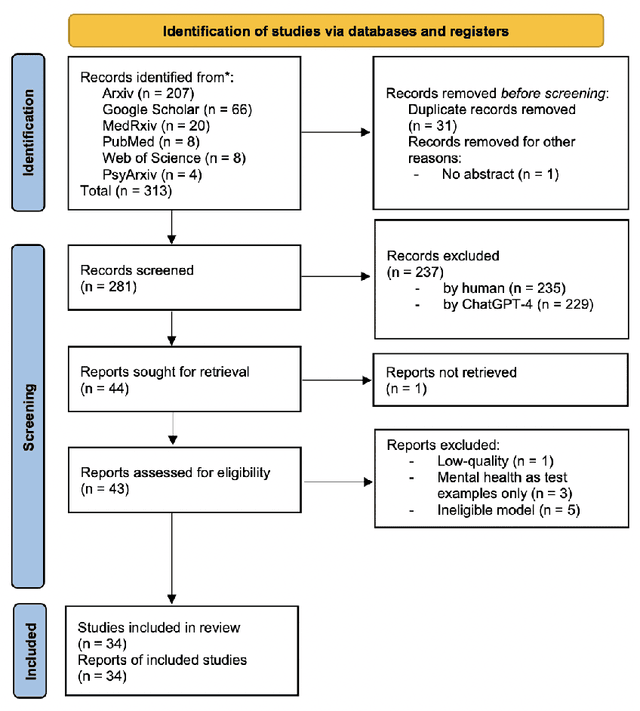
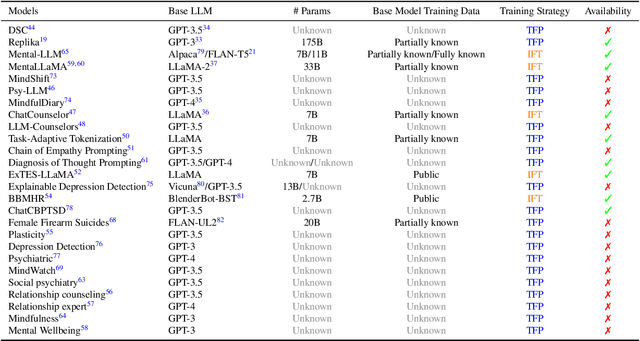
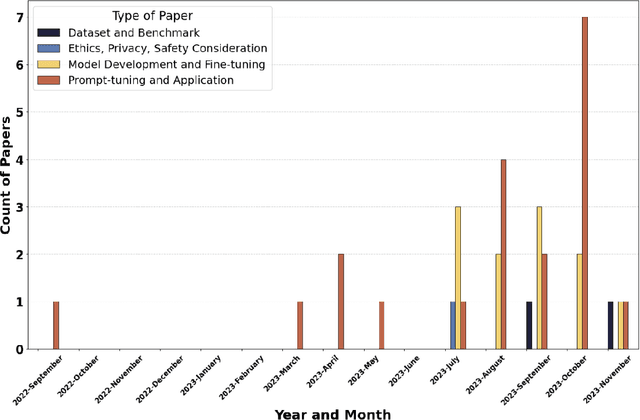
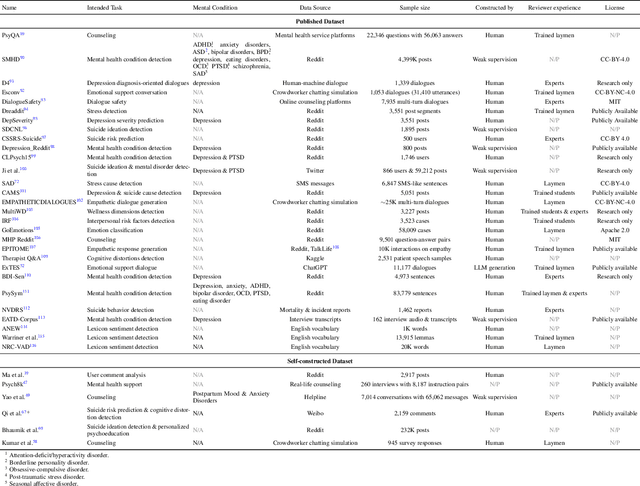
Abstract:Objective: The growing use of large language models (LLMs) stimulates a need for a comprehensive review of their applications and outcomes in mental health care contexts. This scoping review aims to critically analyze the existing development and applications of LLMs in mental health care, highlighting their successes and identifying their challenges and limitations in these specialized fields. Materials and Methods: A broad literature search was conducted in November 2023 using six databases (PubMed, Web of Science, Google Scholar, arXiv, medRxiv, and PsyArXiv) following the 2020 version of the Preferred Reporting Items for Systematic Reviews and Meta-Analyses (PRISMA) guidelines. A total of 313 publications were initially identified, and after applying the study inclusion criteria, 34 publications were selected for the final review. Results: We identified diverse applications of LLMs in mental health care, including diagnosis, therapy, patient engagement enhancement, etc. Key challenges include data availability and reliability, nuanced handling of mental states, and effective evaluation methods. Despite successes in accuracy and accessibility improvement, gaps in clinical applicability and ethical considerations were evident, pointing to the need for robust data, standardized evaluations, and interdisciplinary collaboration. Conclusion: LLMs show promising potential in advancing mental health care, with applications in diagnostics, and patient support. Continued advancements depend on collaborative, multidisciplinary efforts focused on framework enhancement, rigorous dataset development, technological refinement, and ethical integration to ensure the effective and safe application of LLMs in mental health care.
A Survey of Large Language Models in Medicine: Progress, Application, and Challenge
Nov 09, 2023Abstract:Large language models (LLMs), such as ChatGPT, have achieved substantial attention due to their impressive human language understanding and generation capabilities. Therefore, the application of LLMs in medicine to assist physicians and patient care emerges as a promising research direction in both artificial intelligence and clinical medicine. To this end, this survey provides a comprehensive overview of the current progress, applications, and challenges faced by LLMs in medicine. Specifically, we aim to address the following questions: 1) What are LLMs and how can medical LLMs be built? 2) What are the downstream performances of medical LLMs? 3) How can medical LLMs be utilized in real-world clinical practice? 4) What challenges arise from the use of medical LLMs? 5) How can we better construct and utilize medical LLMs? As a result, this survey aims to provide insights into the opportunities and challenges of LLMs in medicine and serve as a valuable resource for constructing practical and effective medical LLMs. A regularly updated list of practical guide resources of medical LLMs can be found at https://github.com/AI-in-Health/MedLLMsPracticalGuide.
Exploring Recommendation Capabilities of GPT-4V(ision): A Preliminary Case Study
Nov 07, 2023



Abstract:Large Multimodal Models (LMMs) have demonstrated impressive performance across various vision and language tasks, yet their potential applications in recommendation tasks with visual assistance remain unexplored. To bridge this gap, we present a preliminary case study investigating the recommendation capabilities of GPT-4V(ison), a recently released LMM by OpenAI. We construct a series of qualitative test samples spanning multiple domains and employ these samples to assess the quality of GPT-4V's responses within recommendation scenarios. Evaluation results on these test samples prove that GPT-4V has remarkable zero-shot recommendation abilities across diverse domains, thanks to its robust visual-text comprehension capabilities and extensive general knowledge. However, we have also identified some limitations in using GPT-4V for recommendations, including a tendency to provide similar responses when given similar inputs. This report concludes with an in-depth discussion of the challenges and research opportunities associated with utilizing GPT-4V in recommendation scenarios. Our objective is to explore the potential of extending LMMs from vision and language tasks to recommendation tasks. We hope to inspire further research into next-generation multimodal generative recommendation models, which can enhance user experiences by offering greater diversity and interactivity. All images and prompts used in this report will be accessible at https://github.com/PALIN2018/Evaluate_GPT-4V_Rec.
Qilin-Med-VL: Towards Chinese Large Vision-Language Model for General Healthcare
Nov 01, 2023Abstract:Large Language Models (LLMs) have introduced a new era of proficiency in comprehending complex healthcare and biomedical topics. However, there is a noticeable lack of models in languages other than English and models that can interpret multi-modal input, which is crucial for global healthcare accessibility. In response, this study introduces Qilin-Med-VL, the first Chinese large vision-language model designed to integrate the analysis of textual and visual data. Qilin-Med-VL combines a pre-trained Vision Transformer (ViT) with a foundational LLM. It undergoes a thorough two-stage curriculum training process that includes feature alignment and instruction tuning. This method enhances the model's ability to generate medical captions and answer complex medical queries. We also release ChiMed-VL, a dataset consisting of more than 1M image-text pairs. This dataset has been carefully curated to enable detailed and comprehensive interpretation of medical data using various types of images.
 Add to Chrome
Add to Chrome Add to Firefox
Add to Firefox Add to Edge
Add to Edge